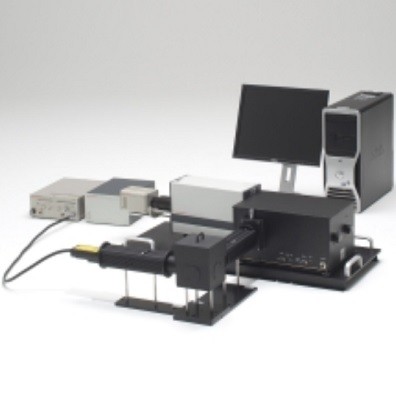Time-resolved Photoluminescence
Features
|
High speed (<15ps time resolution) and quantitative spectroscopic (vis-NIR) detection compatible with a cryostat and all time scales.
Spectrophotometer: Detection wavelength range: 400 nm to 900 nm Detector: Czerny-Turner type (with aberration-corrected toroidal mirror) f=300 mm Measurement wavelength range: 316 nm to 9 nm depending on gratings chosen. Wavelength resolution: 5.1 nm to 0.15 nm Time axis: 1 ns to 10 us /full scale Sweep repetition rate: Max. 20 MHz Temporal resolution (Deconvolution processing): 5 ps Polarization: yes
Laser system: The excitation wavelength, power, bandwidth and pulse can be automatically selected in the Ti:Saph doubled frequency range. Tunable range for freq-doubled output: 355 nm to 460 nm. The system is an ultrafast pulsed Ti:Sapphire laser (Mai Tai XF-1 ), equipped with a femtosecond doubler (3980-6S). (Note: Tunable wavelength range for fundamental: 710 – 920 nm.)
Average Power: > 900 mW at peak > 400 mW at 710 nm > 400 mW at 920 nm Pulse Width: < 70 fs at 800 nm Repetition Rate: 80 MHz ± 1 MHz Polarization: Linear, Horizontal
Femtosecond pulse selector / Doubler: Average Power (at 8 MHz): < 1.0 mW at 395 nm Tuning Range: 360 – 450 nm Diffraction Efficiency: > 60% Contrast Ratio: > 300:1 Repetition Rate adjustable: 8 MHz to single shot Beam Divergence: < 1.5 mrad
Sample types possible: Samples size and format: up to 1.5 x 1.5 cm2 film samples on planar substrate.
Confocal spatial and time-domain photoluminescence (spectrally averaged): Spatial mapping mode is also possible in transmission geometry, within the confocal region of interest (profile). In this configuration, there is no spectrometer for frequency-based TRPL, only streak camera in the spatial domain.
Various objectives available for confocal TRPL: 10x, 50x, 100x
Cryostats: Oxford Instruments closed-loop liquid Helium cryostat for achieving temperatures down to 4 K. Inquire for further specification.
Temperature control stage option for mounting sample: Linkam THMS600 (-190 deg C to 600 deg C) (reflection geometry only, but with limited usability due to 45 degree mounting constraint)
|










